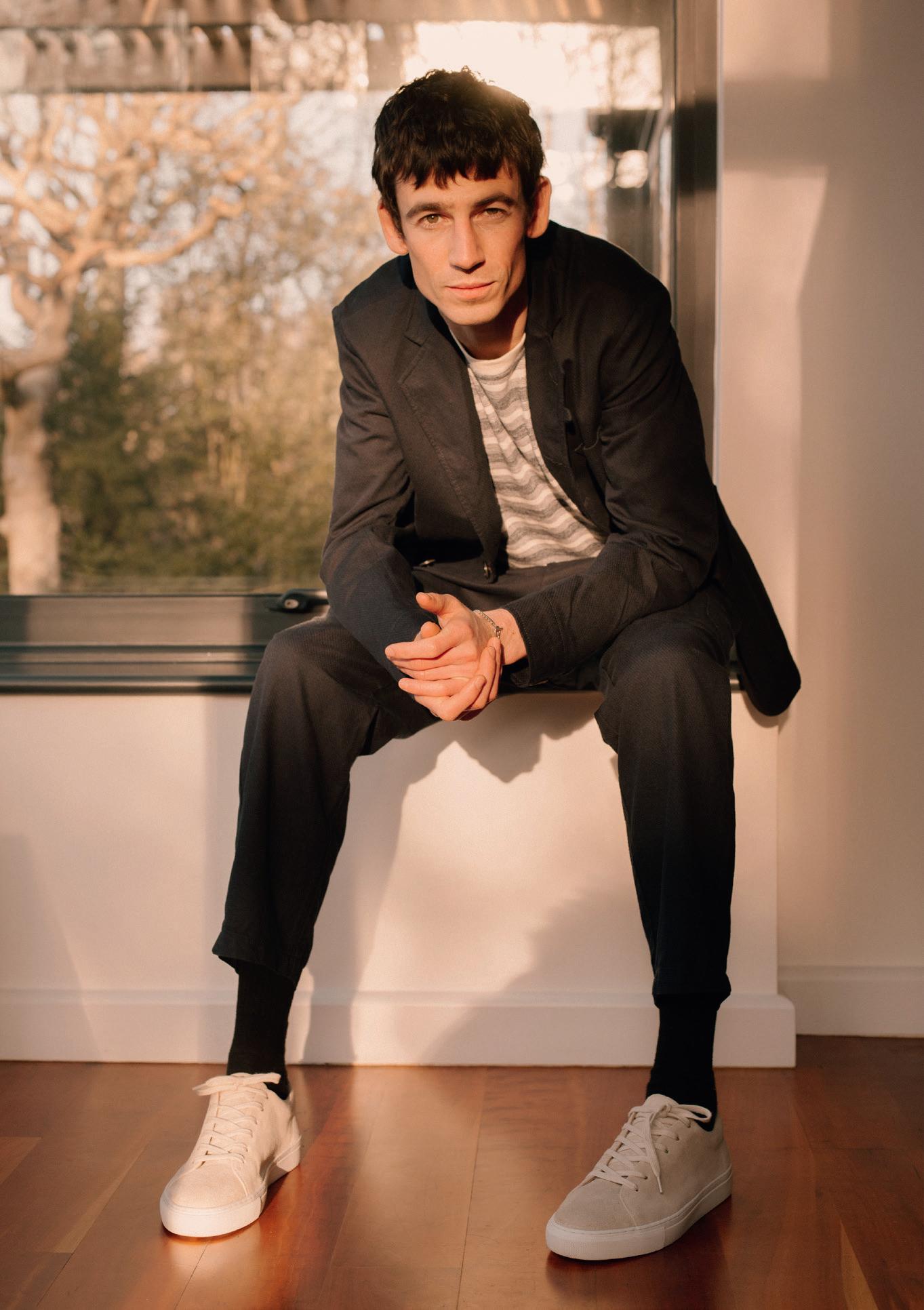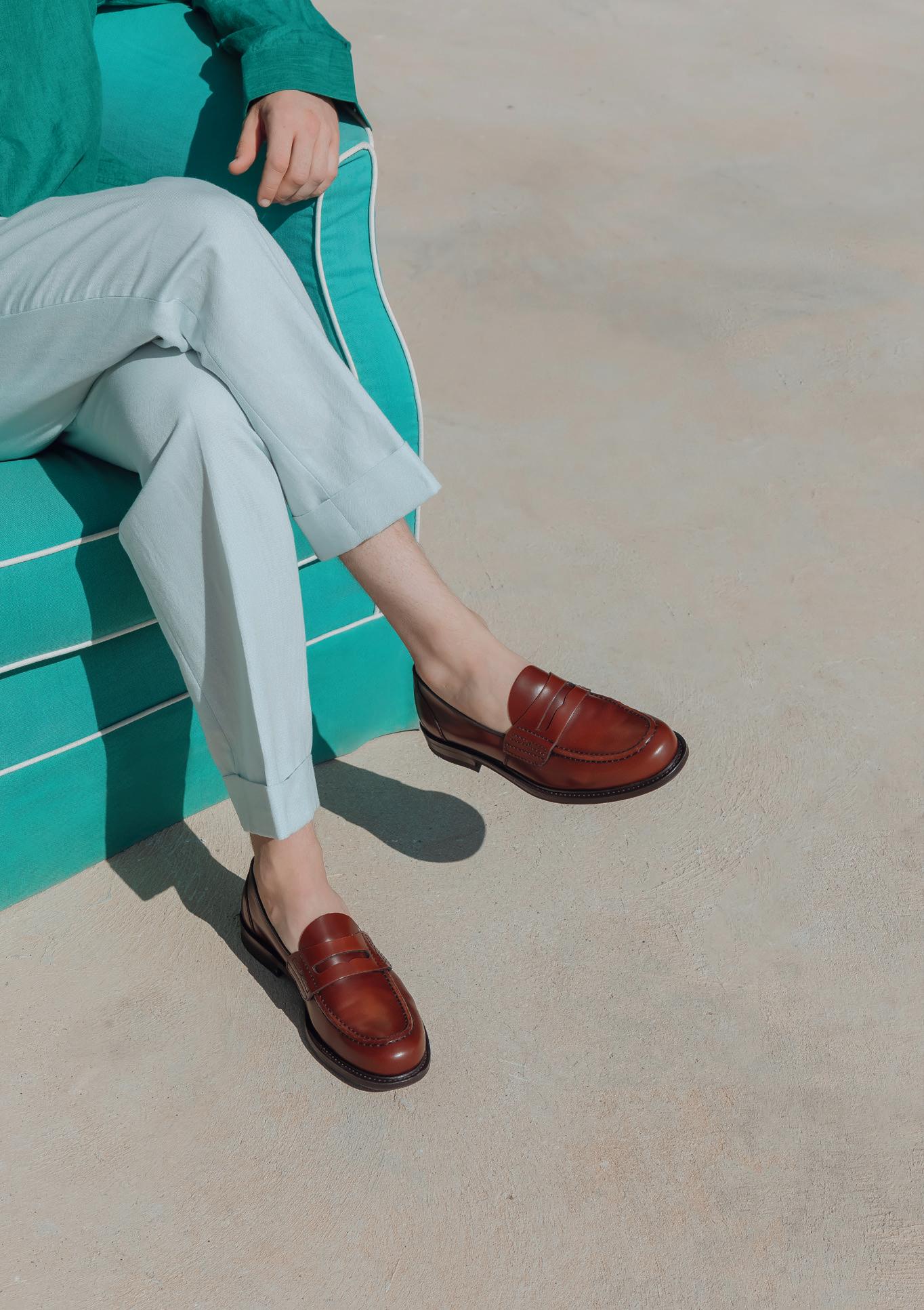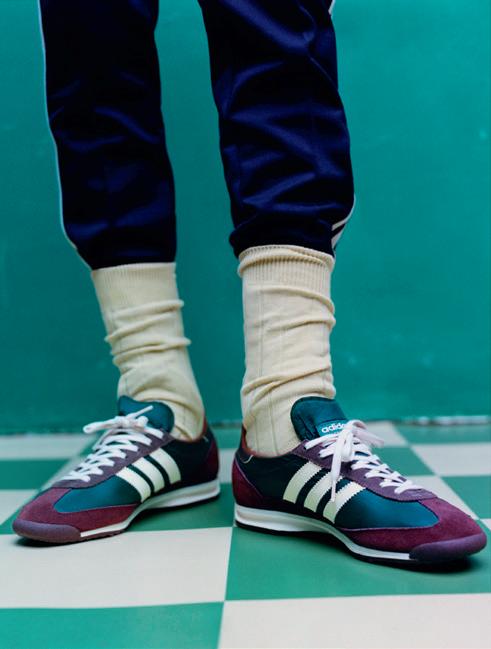
7 minute read
House Dressing by Alex Bilmes
w
ALEX BILMES
Home Dressing
Some of us were never at home with lockdown ‘casual luxe’. Indeed, after a year of T-shirts and trainers, being well dressed could be seen as a radical sartorial statement
Alex Bilmes ► Alex Bilmes is editor-inchief of Esquire and Esquire’s Big Black Book. He also writes for the Financial Times and The Telegraph among others. He lives in West London with his family and a very badly behaved dog.
Opposite ► No Problemo Hat by Aries.
Left ► Relaxed British tailoring by Oliver Spencer.

What was the point of dressing for the office & the post-work cocktail party, when I was to spend the day at the kitchen table, or on the sofa?

Left ► Farsley Bookbinder Fumè Penny Loafer in Tabac, by Church’s. esistance was, ultimately, futile. During the early months of the first lockdown, in the spring of 2020, I tried hard to maintain standards – if only in dress. I told myself it was important that I remain in character, at least during working, if not quite waking, hours, although the border delineating those two became increasingly porous. For me, dressing for work means, or meant, tailoring. Suits, blazers, trousers with creases, business shirts, proper leather shoes, and even a tie. As they say on the internet: I know!
And so each morning, after a shower and a shave – very important to stick to the grooming regime, I felt, not wishing to appear on anyone’s Zoom screen looking like Tom Hanks in Cast Away – I proceeded to select a crisp, freshly laundered shirt and to knot an unnecessary yet attractive slash of silk fabric around my throat, before selecting from one of my parade of formal suits, a sober symphony in charcoal and navy, and shoe-treeing my way into a pair of stiff brogues or shiny Oxfords.
After a time – not a long time – it became apparent that I was engaged in a rather uptight version of cosplay. What was the point of dressing for the office, and the formal lunch meeting, and the post-work cocktail party, when I was to spend the day at the kitchen table, or on the sofa, or even sitting on the stairs, writing emails and eating biscuits, interrupting my virtual meetings only to take the dog out for a stroll around my closest area of rubbishstrewn urban scrubland?
I switched to a more relaxed approach, though still smartish: casual shirts from Sunspel, chinos from Paul Smith, lightweight crewneck sweaters from John Smedley, a soft, unstructured jacket from Oliver Spencer. No tie. (Shh!) For a while I wore my Church’s loafers around the house. But then I switched to trainers.
“Please tell me you’re not wearing jeans,” texted a friend, a fashion stylist who cares very much about these things, when she saw me on a video call in what I can only describe as a T-shirt. “Certainly not!” I typed back. Gentle reader, this was a lie.
In the summer – remember how hot and sultry it was, that first plague summer? – I reconnected with my 17-year-old self and began to shop for limited-edition streetwear, online, at our brilliant national etailers: Matches, Mr Porter, End. I bought a pair of Adidas tennis shoes designed by Grace Wales Bonner. (Never let it be said I don’t do anything for our great British brands.) I bought a baseball cap – a dad hat, as they will insist on calling them – from another excellent homegrown label, Aries. I told myself this was a practical move, to keep the sun off my dad head while dog-walking. “No Problemo” read the legend on the hat. And it felt like there really wasn’t one – a problemo, that is, apart from the apparent collapse of the world was we knew it.

This was, I suppose, another form of cosplay. A more comforting one. My family thought I’d lost the plot and were not too polite to say so. But I was having fun, and Lord knows fun was what was required at that dark time. I never went so far as to buy a tracksuit – it wasn’t that desperate – but hoodies with slogans on them, colourful trainers, trendy Tees, these formed the basis of my pandemic uniform. And then, as autumn shaded into winter, and the news became grimmer, and then the third lockdown began to bite, I grew tired of slouching around in clothes for kidults. The terms began to grate: ‘casual luxe’ (yuck); ‘loungecore’ (sounds like a lamentable music genre for playing in ‘chill-out’ rooms), ‘casualisation’ (Gesundheit!). I am a 48-yearold media executive with children and a mortgage. This whole streetstyle thing was infantilising. Leave it to the kids, grandad, I told myself.
Also the idea – imported, as so many dangerous ideas are these days, from Silicon Valley – that to be casual is somehow to be more modern, more switched-on, more successful, better. It’s incorrect. You shouldn’t take your business ethics from the world-conquering social media barons and the California startup honchos and the fintech nerds, and you certainly shouldn’t take your style pointers from them.
Enough with the logo’d kagoules and the tie-dye socks. I realised that in surrendering to kidult casual, I’d lost something of myself. I missed the feeling that wearing clothes for adults gave me. For me, as for so many others, dressing with a certain amount of effortful formality straightens the back, stiffens the resolve and sharpens the mind. I wanted to be smart again. I missed shirts and jackets and tailored trousers and proper shoes. I missed my beautiful suits! Putting them on again would be like swapping a diet of Deliveroo for a regular table at The Wolseley, like putting down Marian Keyes and picking up Middlemarch, like switching off Strictly and going to the theatre. No disrespect to fast food and pulp fiction and Tess and Claudia, but you can have too much of a good thing.
There is a pointy-headed theory known as ‘enclothed cognition’: what you wear affects not only how others see and feel about you, but how you see and feel about yourself. When you put on a suit, for example, you are saying to the world and yourself that you mean business. When you have finished with business for the day, you can take it off. The line between work and play, blurred to indistinction for so many of us over the past year, is much clearer if you wear a suit. That’s healthy, as any headshrinker will confirm.
I am writing this in early April, as the nation prepares for the lifting of the most stringent lockdown restrictions. In my diary for the weeks ahead are, for the first time in a long time, a handful of in-person work appointments with colleagues and contacts and clients, as well as a number of social engagements: reservations for al fresco lunches and pub garden catch-ups. The sun is out, and yet never in my life have I felt so eager to replace T-shirt and jeans and sneakers with bespoke blazer and leather-soled shoes.
Hard to remember now, so long ago and far away does it seem, but the big story in men’s fashion at the beginning of 2020 was the so-called return of tailoring. At that time, a chap might have been forgiven for scratching his head and wondering, given its continuing ubiquity, that anyone, least of all a fashion designer, could seriously suggest that a daring trend in menswear might be to wear a matching suit jacket and trousers, in a style barely changed in a century.
The fact is that even before the pandemic, formal clothing was facing a serious challenge from dress-down culture. The obituary for the tie has been written, published, pulped, recycled and written again, an endless loop. And yet, I can’t help feeling that, as we drop our tracky bots and shrug off our hoodies and prepare to re-enter the real world, that the tie, and the shirt, and the suit, will have their days in the sun again.
There is, of course, or at least used to be, a notion that to wear a suit is to be a suit. In 2021 a return to dressing to impress is the most radical sartorial statement I can think of.
Opposite, top ► British sprezzatura brands Oliver Spencer & Sunspel take on smart-casual.
Right & Opposite ► Savile Row tailor Kathryn Sargent’s more traditional approach to well-dressed gentleman’s attire.















